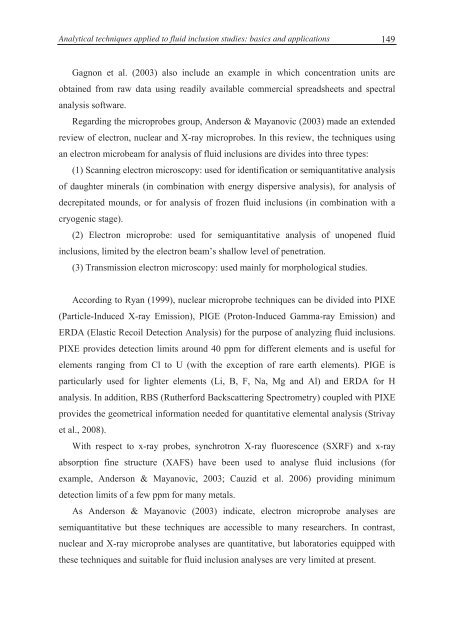instrumental techniques applied to mineralogy and geochemistry
instrumental techniques applied to mineralogy and geochemistry
instrumental techniques applied to mineralogy and geochemistry
You also want an ePaper? Increase the reach of your titles
YUMPU automatically turns print PDFs into web optimized ePapers that Google loves.
Analytical <strong>techniques</strong> <strong>applied</strong> <strong>to</strong> fluid inclusion studies: basics <strong>and</strong> applications 149<br />
Gagnon et al. (2003) also include an example in which concentration units are<br />
obtained from raw data using readily available commercial spreadsheets <strong>and</strong> spectral<br />
analysis software.<br />
Regarding the microprobes group, Anderson & Mayanovic (2003) made an extended<br />
review of electron, nuclear <strong>and</strong> X-ray microprobes. In this review, the <strong>techniques</strong> using<br />
an electron microbeam for analysis of fluid inclusions are divides in<strong>to</strong> three types:<br />
(1) Scanning electron microscopy: used for identification or semiquantitative analysis<br />
of daughter minerals (in combination with energy dispersive analysis), for analysis of<br />
decrepitated mounds, or for analysis of frozen fluid inclusions (in combination with a<br />
cryogenic stage).<br />
(2) Electron microprobe: used for semiquantitative analysis of unopened fluid<br />
inclusions, limited by the electron beam’s shallow level of penetration.<br />
(3) Transmission electron microscopy: used mainly for morphological studies.<br />
According <strong>to</strong> Ryan (1999), nuclear microprobe <strong>techniques</strong> can be divided in<strong>to</strong> PIXE<br />
(Particle-Induced X-ray Emission), PIGE (Pro<strong>to</strong>n-Induced Gamma-ray Emission) <strong>and</strong><br />
ERDA (Elastic Recoil Detection Analysis) for the purpose of analyzing fluid inclusions.<br />
PIXE provides detection limits around 40 ppm for different elements <strong>and</strong> is useful for<br />
elements ranging from Cl <strong>to</strong> U (with the exception of rare earth elements). PIGE is<br />
particularly used for lighter elements (Li, B, F, Na, Mg <strong>and</strong> Al) <strong>and</strong> ERDA for H<br />
analysis. In addition, RBS (Rutherford Backscattering Spectrometry) coupled with PIXE<br />
provides the geometrical information needed for quantitative elemental analysis (Strivay<br />
et al., 2008).<br />
With respect <strong>to</strong> x-ray probes, synchrotron X-ray fluorescence (SXRF) <strong>and</strong> x-ray<br />
absorption fine structure (XAFS) have been used <strong>to</strong> analyse fluid inclusions (for<br />
example, Anderson & Mayanovic, 2003; Cauzid et al. 2006) providing minimum<br />
detection limits of a few ppm for many metals.<br />
As Anderson & Mayanovic (2003) indicate, electron microprobe analyses are<br />
semiquantitative but these <strong>techniques</strong> are accessible <strong>to</strong> many researchers. In contrast,<br />
nuclear <strong>and</strong> X-ray microprobe analyses are quantitative, but labora<strong>to</strong>ries equipped with<br />
these <strong>techniques</strong> <strong>and</strong> suitable for fluid inclusion analyses are very limited at present.













